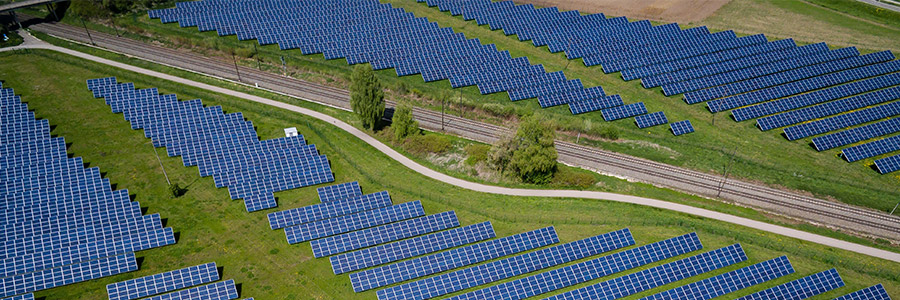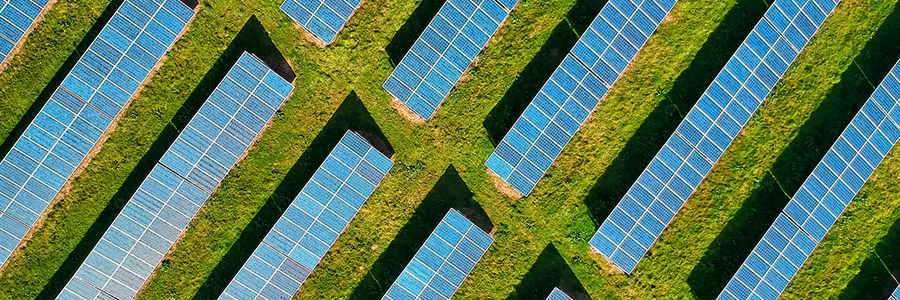Published:
The challenges, guidelines, technical specifications and solutions

The Problem: The Rise of Thefts from Solar Farms
Solar farm theft is a growing concern, with data showing a significant increase in reported incidents over the past few years. This trend highlights the need for enhanced security measures as solar farms become increasingly targeted by organised crime.
- Reported thefts from solar farms nearly doubled from 2021 to 2022, with a further 24% increase from 2022 to 2023.
- The south of England has been particularly hard-hit, with thefts involving massive quantities of cable, up to 50 km in some cases.
- The financial impact on victims is severe, including the cost of replacing stolen materials and lost revenue during the downtime required for repairs.
- Higher insurance premiums often follow these incidents.
- Solar farms under construction are especially vulnerable due to the large quantities of easily accessible materials, such as panels on pallets and cables on drums.
- Repeat victimisation is prevalent; 50% of solar farms in the UK that experience thefts or intrusions twice are likely to face further incidents. This rises to 61% in mainland Europe.
- In Europe, solar thefts cause an average of €60,000 ($63,900) in damage, with organised crime groups seeing rural solar farms as an easy target.

Solar Farms: A Growing Target for Organised Crime
Rural solar farms are increasingly being targeted by organised crime gangs, who view them as an easy source of valuable copper wire. These criminals typically conduct a ‘recce’ of the site to identify access points before returning later to strip the site of materials. In some cases, they even wait until the site has been repaired and restored to working order before striking again.
Without additional funding for replacement panels or wires, the financial burden on solar farms can be significant. The costs of replacing stolen parts, combined with lost revenue from downtime, can have a substantial impact.
Sources: https://securityjournaluk.com/a-spotlight-on-intrusion-in-solar | https://www.pv-magazine.com/2023/04/15/weekend-read-solar-crime-on-the-rise
When applying for planning permission, a local authority may ask a local crime officer to assess the security of a site and make recommendations. Due to the rise of crime in recent years, deer fencing is now not seen as a strong enough perimeter protection system. Therefore, any site, especially large sites which is specifying a perimeter of deer fencing may face issues with planning, as happened with a site in Wakefield in 2023 – Source.
Recent Solar Farm Theft Incidents:
- North Wales: 168 solar panels stolen from two solar farms. Source
- Lincolnshire: 220 solar panels stolen from a solar farm. Source
- Worcestershire: 550 solar panels stolen, with £100,000 worth of recovered panels. Source
- Northamptonshire: 80 solar panels stolen from a solar farm. Source
Other Security Considerations:
Solar farms are also at risk from saboteurs and protestors opposed to renewable energy projects. Though they may not profit from the stolen equipment, their vandalism can disrupt energy generation and result in significant repair costs.
Additionally, unauthorised access to solar farm land, whether intentional or due to poor perimeter security, poses a safety risk. Injuries sustained on-site could result in liability for the landowner, leading to potential legal costs and increased public liability insurance premiums if the site boundaries are not adequately secured.
Key Considerations for Solar Farm Perimeter Fencing
- Effective Perimeter Demarcation: Ensure the fencing clearly defines the boundaries of the solar farm.
- Security Solutions: If security is a priority, the fence should offer robust protection against unauthorised access.
- Adaptability to Terrain: The system must be suitable for installation on uneven or sloped ground and withstand high winds and harsh weather.
- Environmental Integration: The fencing should blend seamlessly with the natural surroundings to minimise visual impact.
- Wildlife-Friendly Design: Choose a system that deters larger animals while allowing smaller creatures and insects to pass through.
- Durability and Maintenance: The fence should last the entire lifespan of the solar farm, be easy to repair if needed, and have low ongoing maintenance costs.
- Compliance with British Standards: Ensure the fencing meets all relevant British Standards and accreditations.
- Secure Access Points: Access points should complement the fence system and maintain overall site security.
- Scalability: The system should be easily expandable to accommodate any future growth of the solar farm.
- Cost: Consider the initial investment relative to the security level provided, along with the long-term maintenance expenses.
Deer Fencing & Weld Mesh Fencing
Specifying fencing for solar farms typically involves choosing between two primary options: the traditional deer fencing, which provides effective perimeter demarcation while being wildlife-friendly, and the modern weld-mesh security fencing, which offers significantly enhanced protection against intruders.
Deer Fencing – A traditional solution that uses galvanised steel wire on rolls that is normally attached to wooden posts. The main benefits of this type of fencing are:
- Protection from Larger Animals: Deer fencing is specifically designed to prevent deer and other large animals from entering the solar farm, protecting equipment from damage caused by wildlife.
- Environmental Sensitivity: Deer fencing is often seen as a more environmentally friendly option, as it allows smaller animals to pass through, minimising disruption to the local ecosystem.
- Lower Initial Cost: Deer fencing typically has a lower initial cost compared to high-security options like weld-mesh fencing, making it an attractive choice for projects with tight budgets.
Weld-Mesh Fencing – A modern solution that uses galvanised and powder-coated weld-mesh panels attached to metal posts and fixings. The main benefits of the type of fencing are:
- Anti-Climb Design: The tight mesh design of weld-mesh fencing is difficult to climb, adding an extra layer of protection against intruders.
- High Strength: Weld-mesh fencing is made from thicker galvanised steel wires, with added powder coat protection, providing long-lasting resistance to wind and corrosion.
- Easy to Replace in Event of Damage: Individual panels can be swapped out quickly, without having to re-install large runs of fencing.
- Meets Security Requirements: Weld-mesh fencing can meet higher security standards and accreditations, which may be required for certain solar farm installations.

National Guidelines For Solar Farm Fencing
From BRE (Building Research Establishment) – Guidelines for Solar Farm Perimeters
The BRE national guidance provides best practice planning guidance in respect of how large ground mounted arrays are developed setting out planning considerations and requirements.
- Minimise the use and height of security fencing to reduce visual impact.
- Utilise existing features like hedges or landscaping to screen security fencing.
- Minimise security lighting and use PIR technology to reduce glare, light pollution, and impacts on biodiversity.
- Ensure measures are in place to allow continued access by larger mammals, like badgers and foxes. It is advised that large buffer strips (at least 4-5m) are left between perimeter fencing and hedges.
- Include full details and specifications of security and lighting installations in planning applications for accurate assessments.
- Carefully consider the location of pole-mounted CCTV facilities to minimise visual and landscape impact, avoiding exposed landscapes when possible.
Police Guidelines (from Devon and Cornwall Police)
- A risk assessment should be carried out if placing large number of photovoltaic panels in an isolated location.
- If perimeter fencing is to be used then it should be a proven security fence.
- It is recommended that the chosen fencing system has been tested and approved to current UK Government standards.
- The fencing should meet a security rating standard.
- There should be a minimum number of vehicular access points onto site, ideally only one.
- The boundary protection of the site should be an appropriate distance from the actual panels to discourage parking a vehicle against the site boundary.

Solar Farm Security Guidelines from Insurers
Insurers offering coverage for solar farms have outlined specific security requirements that must be met for a policy to be issued.
Here are the key factors insurers will assess:
- Access Control: How is access to the site managed and secured?
- Perimeter Security: Is the site perimeter secured with fencing? If so, what type, height, and security ratings does it meet?
- Compliance Standards: Does the perimeter fencing meet BS1722-14 standards?
These factors do not just apply to new solar developments. If during an assessment the insurer considers the perimeter security inadequate, then additional security measures may be required, such as monitored CCTV with infrared lighting, which can be expensive to install or retro-fit to existing fencing, and also come with extra ongoing costs.
Installing robust perimeter security fencing and access gates that meet insurer standards can help fulfil security requirements, potentially avoid higher premiums, and reduce the risk of scrutiny in the event of a claim.
*Guidelines provided by Lycetts Insurance Brokers & Financial Services.
British Standards For Steel Mesh Fencing (BS1722 Part 14)
BS1722 Part 14 sets minimum performance standards for various types of weld-mesh fencing.
The standard covers four main fence categories:
- General Purpose Fences: Up to 2.4m in height.
- Boundary/Perimeter Fences: Minimum height of 2.4m.
- Security Fences: Minimum height of 3.0m, including topping.
- Higher Security Fences: Minimum height of 3.0m, excluding topping.
The standard also specifies wire thickness and aperture spacing for each fence type:
General Purpose / Boundary / Perimeter Fences:
- 4.5mm horizontal / 3.75mm vertical wires
- 200 x 50mm apertures (e.g., V-mesh or twin-wire)
Security / Higher Security Fences:
- 4mm horizontal / 4mm vertical wires
- 12.7 x 76.4mm apertures (e.g., prison mesh)
It is essential that any weld-mesh fencing system meets the minimum wire thickness specified in BS1722:14. Certain systems on the market that are value engineered, do not meet the thickness requirement.
If a consultant, risk assessment or insurer specifies a ‘security fence’, two options meet the British Standard for this class: a 2.4m prison mesh with extended posts and a topper or a 3.0m prison mesh system.

Access Gates For Small Animals
Maintaining the natural movement of wildlife, such as badgers or foxes, across solar farm perimeters is essential for environmental sustainability. Badgers establish well-defined pathways over time, and when these paths are blocked by fencing, it can lead to harmful outcomes, such as trapping, injury, or attempts to breach the fence.
- Specialised wildlife access gates should be installed where these paths intersect with fence lines.
- These gates allow small mammals like badgers to pass through while preventing larger animals from entering.
- Our wildlife access gates seamlessly integrate with mesh fencing systems, including a custom gap and powder-coating for aesthetic consistency.
- Gates can be configured to open in one direction or both, ensuring flexible wildlife access without compromising security.
Security Fencing For Solar Farms
Weld-Mesh Boundary Demarcation Fencing
(Such as SolarGard Orbit)
V-mesh fencing systems provide a perimeter security fence that is aesthetically pleasing with high through-visibility, helping it to blend into its surroundings.
This type of mesh fencing is generally cost-effective and provides an effective anti-climb deterrent. Adjoining panels are held together with metal clips that are then pinned into posts using pre-drilled holes.
We recommend this type of weld-mesh fencing as a demarcation fence, where security is not critical. The single-wire mesh with v-folds provides a system that is more durable than deer fencing, and can easily be stepped for uneven ground.
Security Rated Boundary Fencing
(Such as SolarGard Aurora)
Security (SR) rated fencing has been tested and approved by a third-party industry body or organisation, usually the LPCB (Loss Prevention Certification Board).
SR1 security fencing can withstand opportunistic attempts at forced entry using basic tools such as cable cutters, screwdrivers, knives and hammers, for a period of time. This, combined with stronger mesh panels and fixings, creates a security fence that is very hard to climb, cut through or force entry.
We recommend this type of weld-mesh fencing is used where a security rating is important, but ensuring good sight lines is still important. The overlapping wires, stainless steel fixings and full-length clamp bars ensure a higher level of security over v-mesh.
Security Rated Security Fencing
(Such as SolarGard Titan)
Security (SR) rated fencing has been tested and approved by a third-party industry body or organisation, usually the LPCB (Loss Prevention Certification Board).
To be classed as a security fence, the panel must have a tightly spaced mesh. This creates a security fence that is very hard to climb, cut through or force entry. Combined with SR1 rating, this system can withstand opportunistic attempts at forced entry using basic tools such as cable cutters, screwdrivers, knives and hammers, for a period of time.
We recommend this type of weld-mesh is used where security is the top priority. The narrow apertures of the mesh panel make climbing almost impossible, while the fixings are hard to tamper with.

Effective Solar Farm Perimeter Security
Securing your solar farm with a robust fencing system is crucial for protecting your investment and ensuring the site’s long-term operation. While deer fencing may seem like a more cost-effective solution initially, it does not offer the same level of protection against theft or intrusions. Opting for a security-rated fencing system may involve a higher upfront cost, but it will significantly reduce the risk of break-ins, damage, and costly downtime. When you consider the financial impact of theft, lost revenue, and increased insurance premiums, investing in a high-quality security fence becomes a far more economical and reliable choice in the long run.
At Alexandra we understand the challenges that contractors face every day (many years ago we were once contractors ourselves) and we’re committed to supporting you every step of the way, by making your life easier and eliminating uncertainty.
We can recommend a complete system for solar farm security installers. We also have a network of approved installers all across the UK, who are able to provide site surveys in areas near them. We can provide on-time delivery direct to site, or if you are in the south-east; collect directly from us.
Contact our team today for a competitive quote on any of the mesh security systems.






